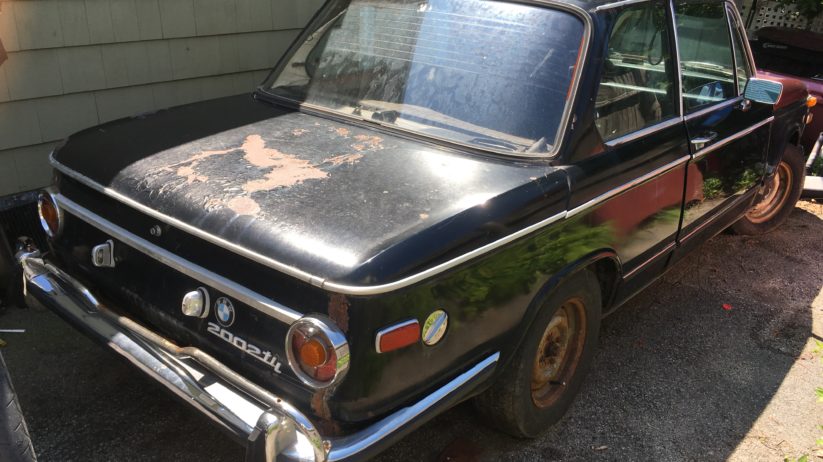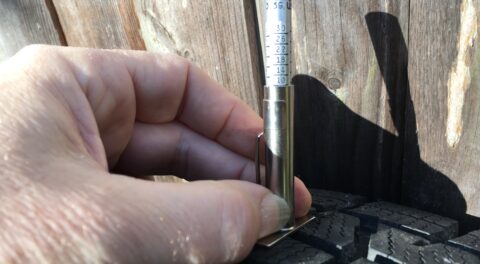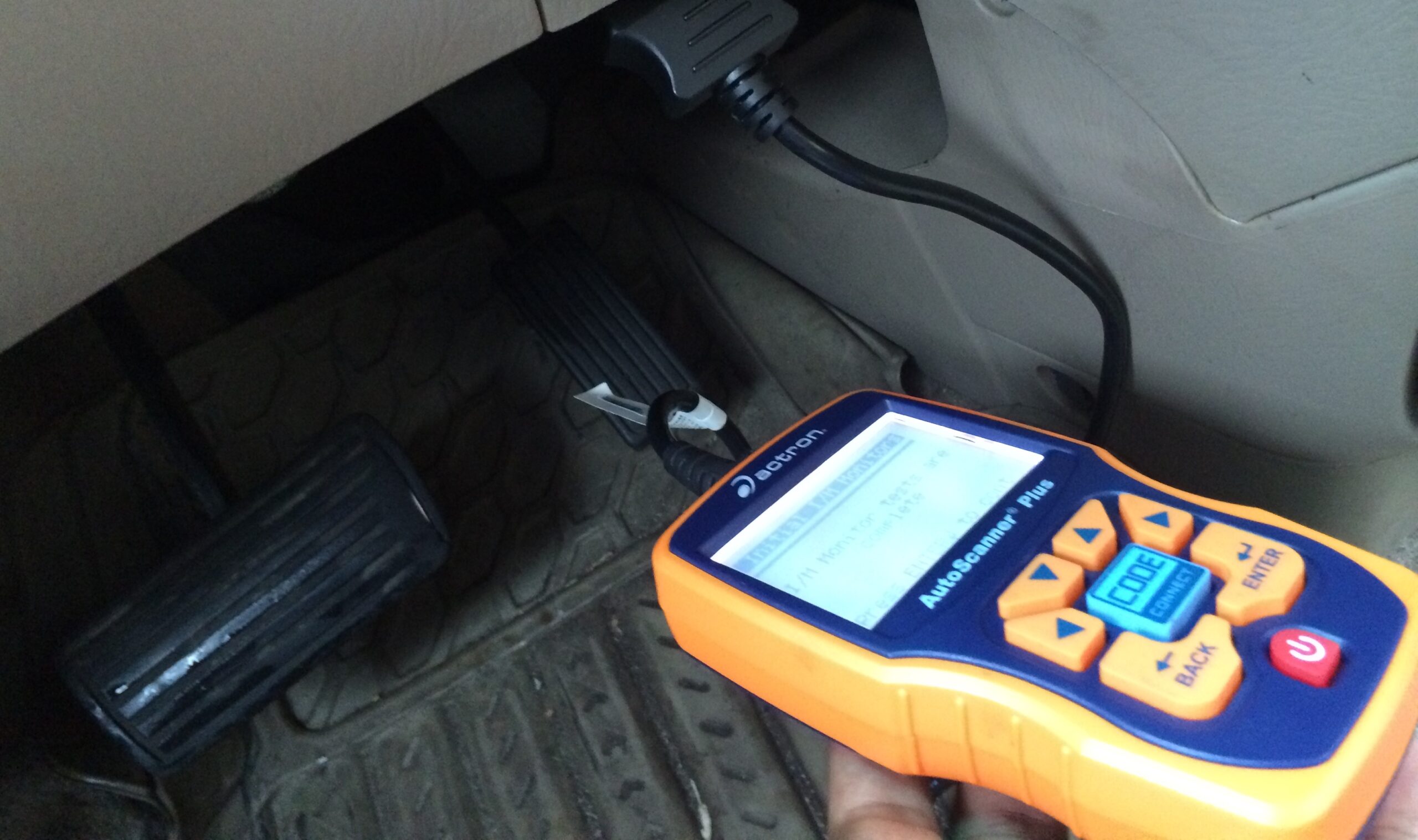(With apologies to Ernest Hemingway and Francis Macomber)
A few months ago, I wrote about being offered and accepting a free faux tii—a 2002 into which someone had transplanted a tii fuel-injected engine and tii front struts, calipers, brake booster, and master cylinder. I’d first seen it last year when it was for sale on Craigslist; I found it to be a rusty, ratty car that had been sitting outside for some time, and passed on it.
But last spring, out of the blue, the owner contacted me and offered the car to me for free. I drove back down to Brockton and looked at it again, and while I neither needed nor wanted a parts car, and while space and long-term storage in my driveway is an issue, the pluses far outweighed the minuses, particularly when my friend Tom was willing to go get it with his truck and trailer. The owner swore that last year he’d cranked it over and gotten the engine to run on starting fluid, but that was just an odd bit of trivia; my decision to take the free car wasn’t predicated on its veracity.
Tom and I towed the car back to my house and dropped it at the end of the driveway behind the RV. This was late April. Then a bunch of things happened: I did the big push to get Bertha, my resurrected ’75 2002, down to the Vintage and back. I got my long-dead Lotus Europa not only up and running, but sufficiently sorted to begin driving it regularly. I worked on the a/c in my 3.0CSi. Finally, family issues took up a lot of my time.
The faux tii was largely out of sight and out of mind behind the RV.
By late July, things had calmed down a bit. Maire Anne and I took a little three-day vacation up to Maine in the RV. While prepping and packing the RV and moving it, while I was three feet from the faux tii, the wafting scent of stale gas alerted me of its corporeal existence, and reminded me why I didn’t really want a dead parts car in the driveway.
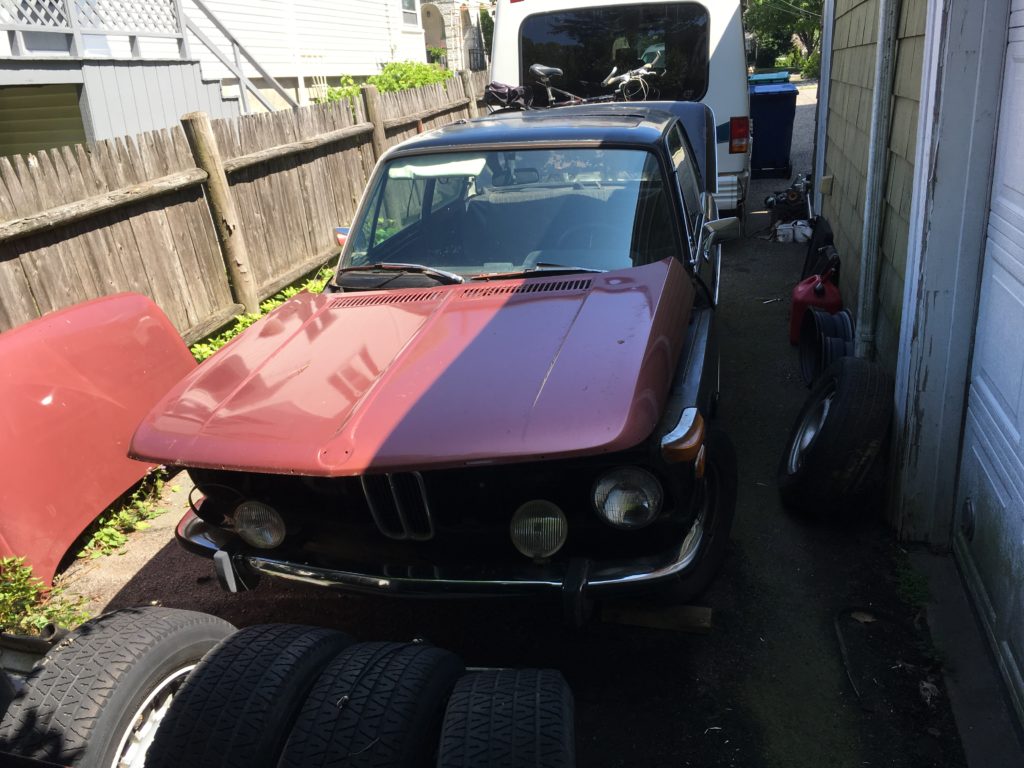
The faux tii kept the Siegel ancestral stash of junked wheels and tires company.
So this week I changed the channel and tuned in the faux tii.
When I accepted the free car, I hadn’t really thought through what I was going to do with it. It was clear to me that with its badly rotted floors, awful general condition, missing interior, boogered wiring from a battery location to the trunk, and lack of a tii VIN, it was a parts car. However, even knowing the high value of the tii front struts, I had no desire to do the work necessary to part the entire car out in my driveway and dispose of the stripped hulk.
As I circled the dead beast (and got its scent of stale gas on me), it became clear to me how I should treat it: I should do what I’ve done with the other dead cars that have recently crossed my path, from the Turkey to Louie to Old Blue to Bertha to the Lama to the Lotus: I should try to get it running.
Why? First, it’s what I do. Second, even if I were to part the car out, the value of the engine would be higher if I could ascertain its condition, especially if that condition was “Runs and doesn’t lay down a fog of oil like James Bond’s DB5 in Goldfinger.” Third, if I got the engine started, from there I’d likely slide down the slippery slope to getting the car moving and driving. This is both a good thing and a bad thing, sort of like the wave-particle duality of light in quantum mechanics, with not only an equally compelling case for both, but both being actually true.
However, to be clear, I was looking at scaling the mountain of this project from the practical side, which is believing that there’s no easier container to transport a running engine than a running car (that is, selling it as a faux tii parts car with a running tii engine), as opposed to the altruistic every-2002-must-be-saved steepest-ascent side. The only people who climb that side of the mountain are crazy Germans. Well, and Mike Miller.
But whichever approach I was using, I was going in. Up. Somewhere.
After I re-verified that the engine turned freely, the work began, as it often does, with the fuel system. Cars that sit for years have the gas turn to varnish, and it was clear that this fate had befallen the car, since, as I said, I could smell the varnish simply by walking past the back end of the car; when I stuck my nose in the filler neck, the smell was overpowering.
On a carbureted car, you can bypass the fuel tank and try to start the engine by running it off a gas can—or just unscrew the tops of the carbs and manually fill up the float bowls—but on an injected car, with the fuel pump in the back and a fuel-return line, using a gas can is a bit more challenging. So I drained the tank, dumped the disgusting old smelly fuel into a can, removed the pickup tube and level sensor, and looked inside.
It was about what I expected: gummy varnish plus rusty scale.
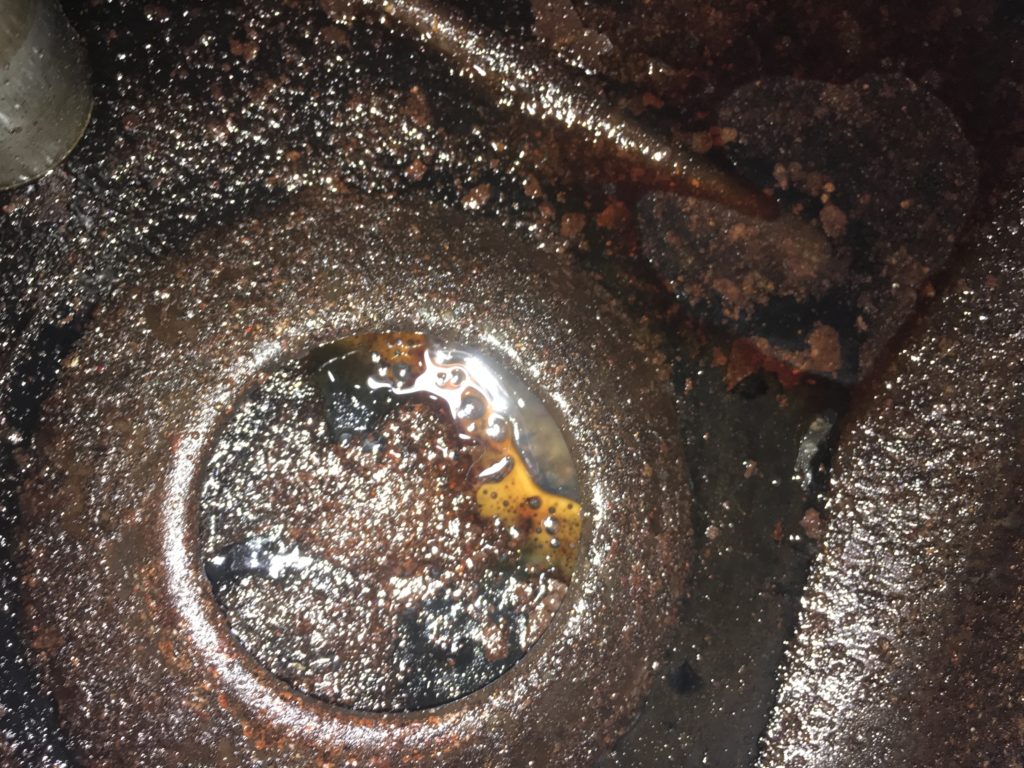
Ick, Phase One.
I removed the tank, threw in a chain, shook it around to dislodge the first layer of rusty scale, reached in with a Scotch Brite pad, scrubbed wherever I could reach, gave it a rinse and a shake, and dumped that into a can. I then let the tank dry overnight. In the morning, it still absolutely stank of varnish. On examination, I saw that there were still big gooey globs, like flattened pieces of Silly Putty, stuck to the bottom.
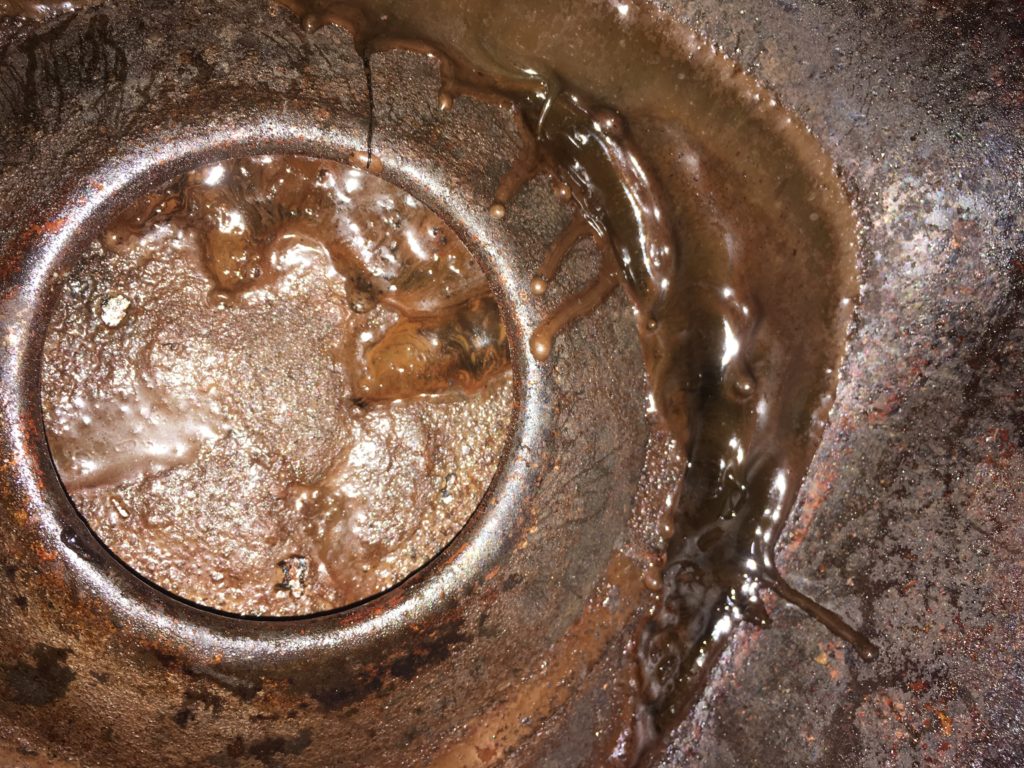
Ick, Phase Two.
I reached in with a spoon and scraped up the goo. The hardest area to clean was the crater-like recess where the bottom of the pickup tube sits, but I did the best I could. It was difficult and, shall we say, fragrant work.
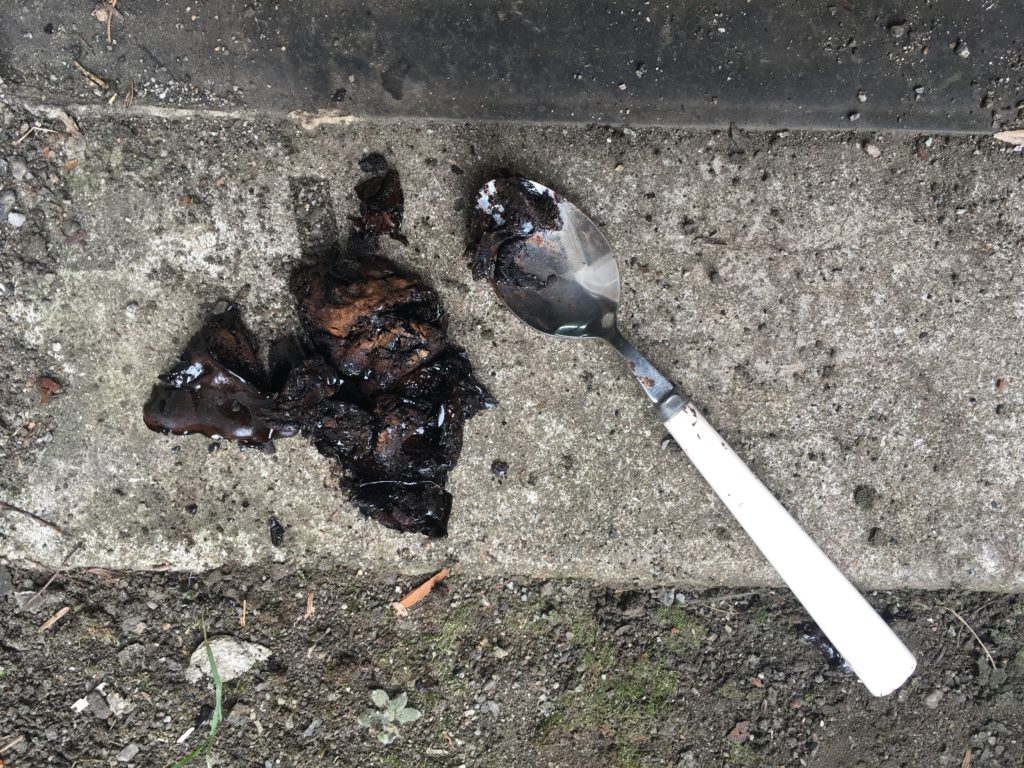
Yes, I scooped varnishy gas goo with a spoon. Ya want sprinkles on that?
Several times I stopped and thought, “This is stupid. You should take the tank to a shop and get it boiled out.” But I reminded myself that I wasn’t trying to put the car back on the road, I was simply trying to get it started. I hated to spend real money cleaning a tank for what was almost certainly a parts car.
After a few more scrapings and rinsings, the tank looked pretty good, especially in comparison to how it started. It wasn’t perfect, but I reminded myself that the goal was simply to clean the tank well enough that, with a filter in line, it wouldn’t contaminate the rest of the fuel system. It met that goal. I put the tank back in. The rubber filler-neck boot was torn to smithereens, but that isn’t an impediment to trying to start a car.
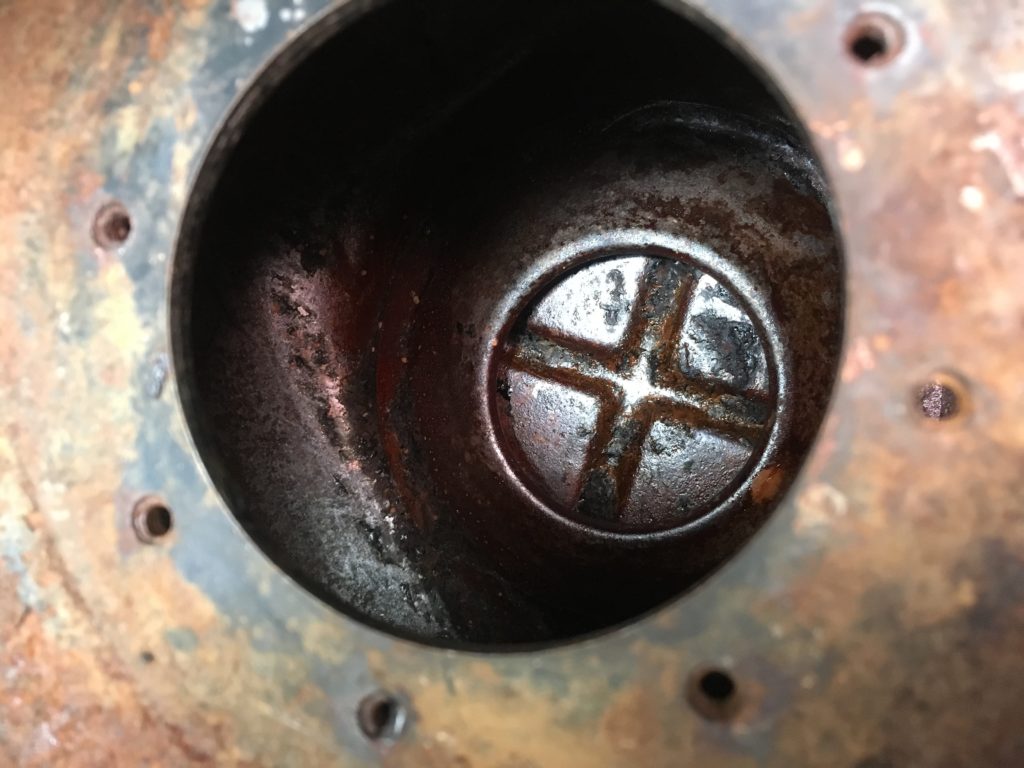
As they say in business, perfect is the enemy of good.
I then inspected the pick-up tube. I blew out both the send and return tubes with compressed air, and was relieved that they were clear (on Old Blue, they were completely clogged, requiring hours with a coat hanger, solvent, and compressed air). I cleaned the fragile mesh screen as best I could; you can still see some rust under it, but whenever I’ve tried to pry these off, I’ve destroyed the mesh. I let this one be for now; I may give it another round of cleaning before re-installing it.
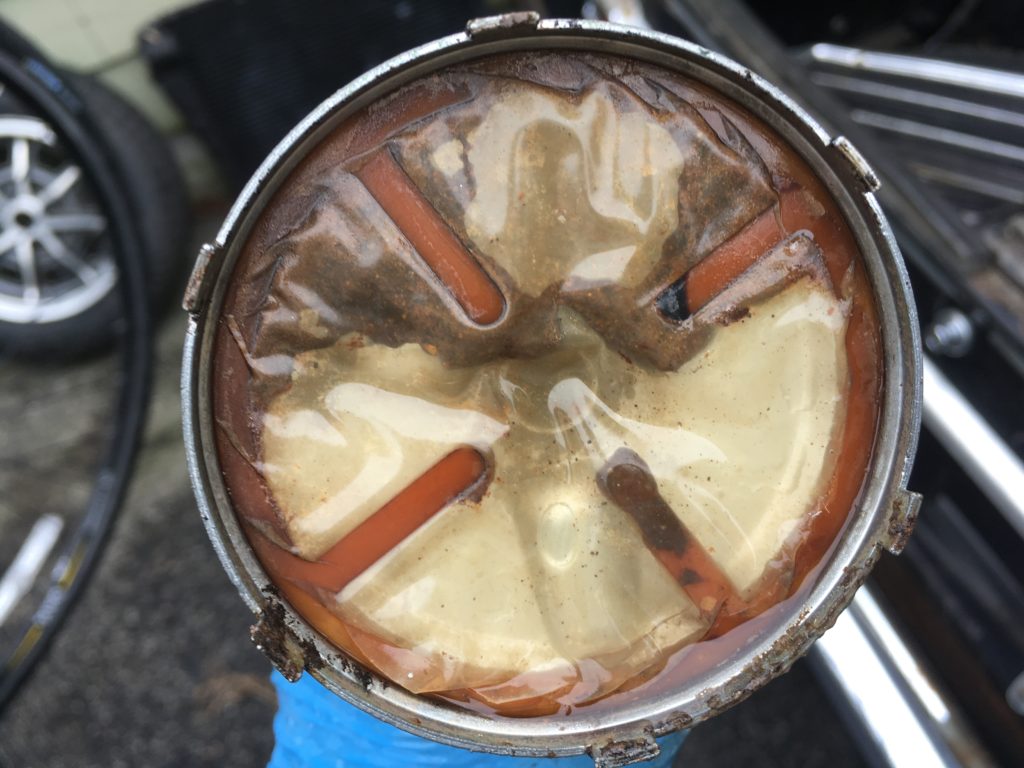
The fuel screen at the bottom of the pick-up tube after a partial cleaning.
Next, I moved to the fuel pump. Tii’s use a high-pressure pump that’s mounted under the car, just forward of the gas tank; it pumps fuel at about 60 psi through the metal send line. A pressure regulator valve on the back of the Kugelfischer injection pump regulates that down to 29 psi and sends the unused fuel back to the tank through a plastic return line.
The pump is clamped into a bracket that includes a small expansion canister. That bracket is suspended from a second fixed bracket that’s welded to the underbody of the car. Three rubber vibration-isolation bushings attach the two brackets together. Thus, on a faux tii, one question is whether the person who originally did the work welded an original fixed bracket to the underside, or kluged something together to hold the fuel pump. It has to be secured somehow.
When I looked under the car, what I found was an original tii fuel pump, expansion canister, and bracket, all swingin’ in the breeze like a pair of truck nuts on the back on an F350 in Laredo.
Huh.
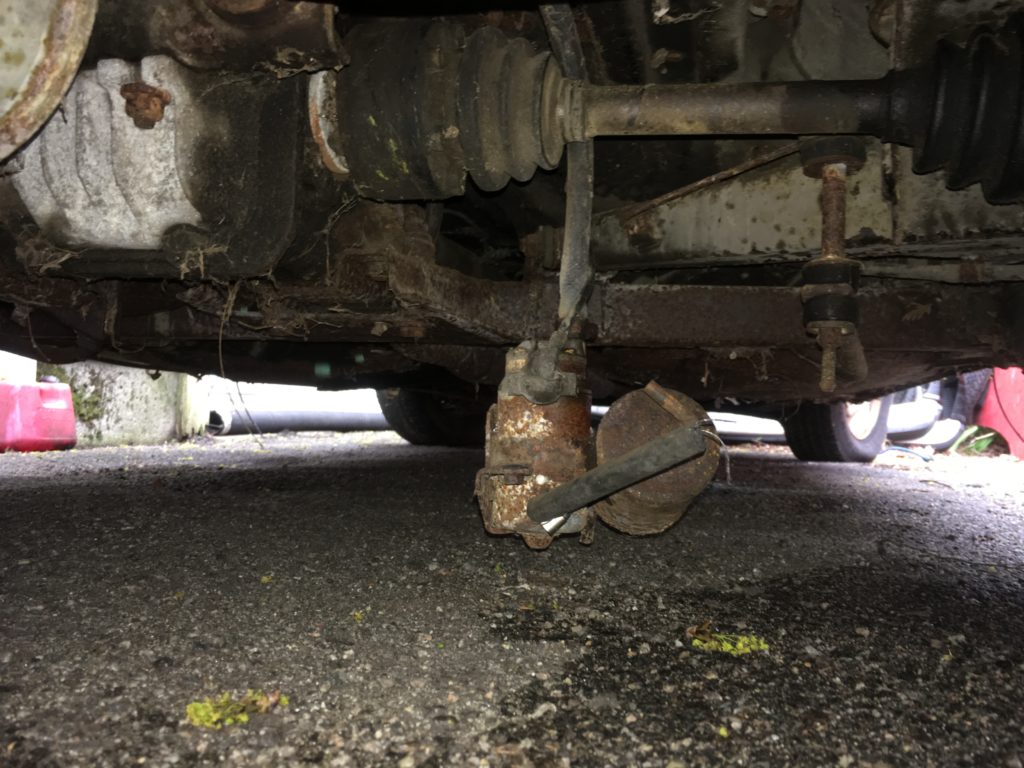
A free-range fuel pump.
The fuel pump was dangling by the fat rubber fuel hose connected on the inlet side. When I crawled under and looked above it, I did see a rust-and-cobweb-encrusted fixed bracket attached to the underside of the car, held in place with some sort of black epoxy, and looking like David Cross stuck to the ceiling in the morgue scene in Men In Black II.
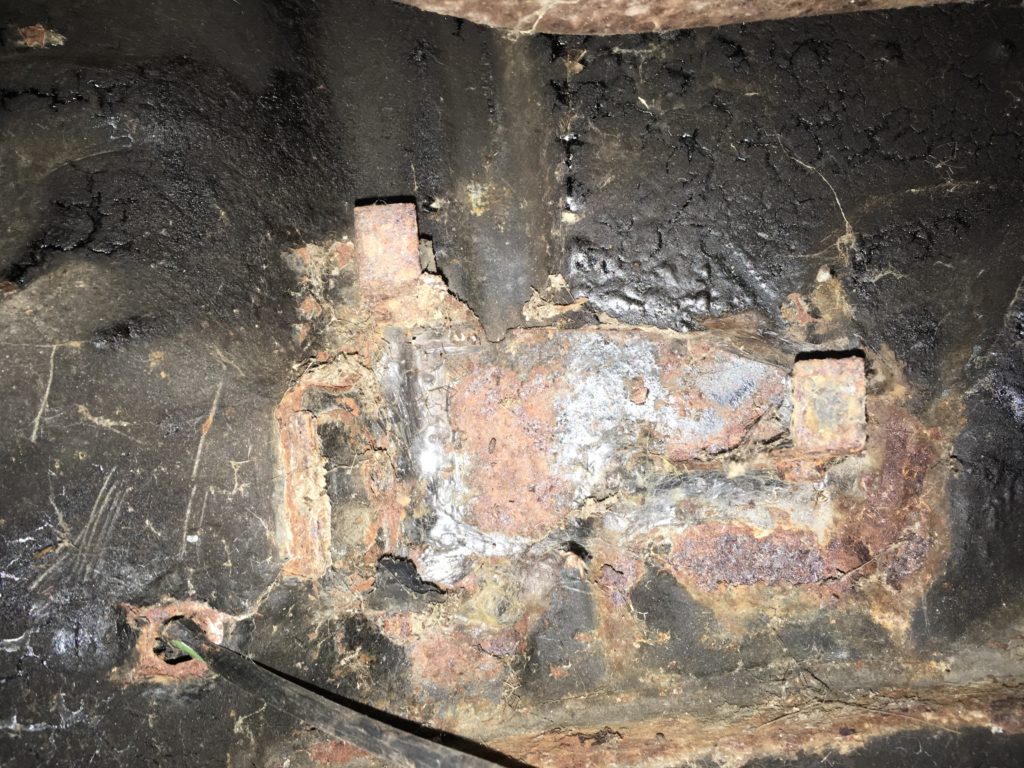
It’s difficult to tell, but this is a bracket.
I disconnected the fuel pump from the rubber inlet hose, and a stream of disgusting, varnish-smelling gas ran out. I blew the inlet of the pump out with brake cleaner and inspected it. I’ve seen these completely clogged up with rusty scale and sediment, but this one looked okay. Then I looked more closely. The inlet to the original fuel pump is supposed to have a little conical mesh screen in it. The screen on this one was missing. This was odd, as when I’ve tried to pull the screens out to clean them, I’ve rarely been able to.
I ran compressed air through the expansion canister, then tested the pump by wiring it straight to a battery. I found that it was seized. I rapped it lightly with a wrench, but it didn’t free up. I have a couple of working tii pumps that I’ve replaced prophylactically. I pulled one out, tested it, and put it with the original one for later.
The next question on a faux tii is how the fuel send line is plumbed. Unlike 2002s, which use a plastic line that runs inside the passenger compartment, tii’s have a metal fuel send line that runs under the car. So when you convert a 2002 into a faux or tribute tii, you need to run a securely-mounted high-pressure fuel line. On this car, what I found was what appeared to be two lengths of unsecured 5/16″ metal brake line, spliced together with a union. The back end—the end that was supposed to be connected to the expansion canister—was hanging in the air.
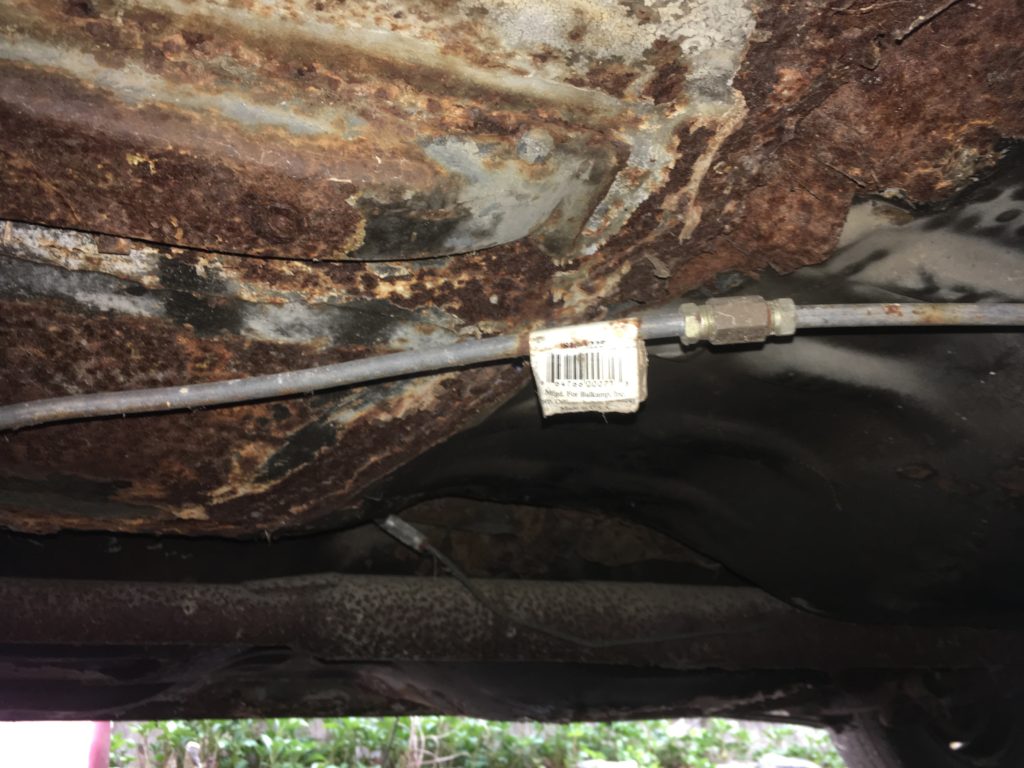
At least the makeshift hard fuel line was new enough to have the tag still on it.
It got weirder.
I went to the engine compartment and found where the metal line emerged. It was connected to a rubber hose that ran to the back of the Kugelfischer injection pump. However, also in the engine compartment was a generic low-pressure fuel pump, likely good for about 4 psi. That and a little fuel filter were just sitting on top of the brake booster and master cylinder. Its input side was connected to the standard fuel-return line. The output line was torn, but I could see where it had been connected to the input side of the Kugelfischer pump.
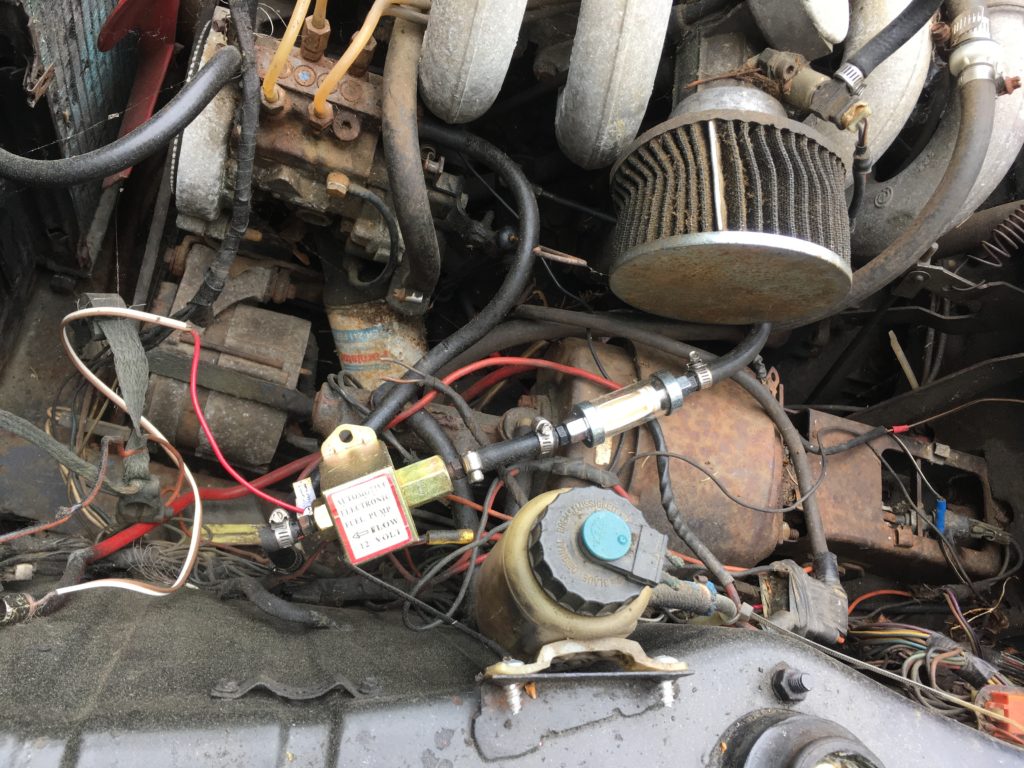
Um, yeah…
I tried to do some forensics, imagining how this abomination came to be. My guess was that the fuel system had originally been plumbed properly, but that the rear-mounted high-pressure fuel pump had seized, and a previous owner tried to substitute a low-pressure fuel pump and connected it to the plastic return line, not understanding that it would never work due to woefully insufficient fuel pressure. I suppose that the fact that the pump’s low fuel pressure insured that fuel would never make it past the pressure-relief valve meant that the valve being connected to what was supposed to be the metal send line, and that line just hanging in space in the back of the car, didn’t really matter.
In that convoluted sentence, I’ve probably analyzed it and thought about it more than whoever was responsible for doing it.
I removed the silly extraneous low-pressure fuel pump, then used compressed air to blow out the metal send line, the plastic return line, and the thick rubber line that connects the send port on the pick-up tube to the fuel-pump inlet. More stinky varnishy fuel dribbled out.
I was about to take the garden hose and wash down the asphalt under the car when I noticed an odd pointy piece of metal sticking out of the thick rubber fuel line. I tugged on it with my fingers, and out popped the conical screen that was supposed to be in the fuel-pump inlet. The inside of it was just as gummed-up as I would’ve expected.
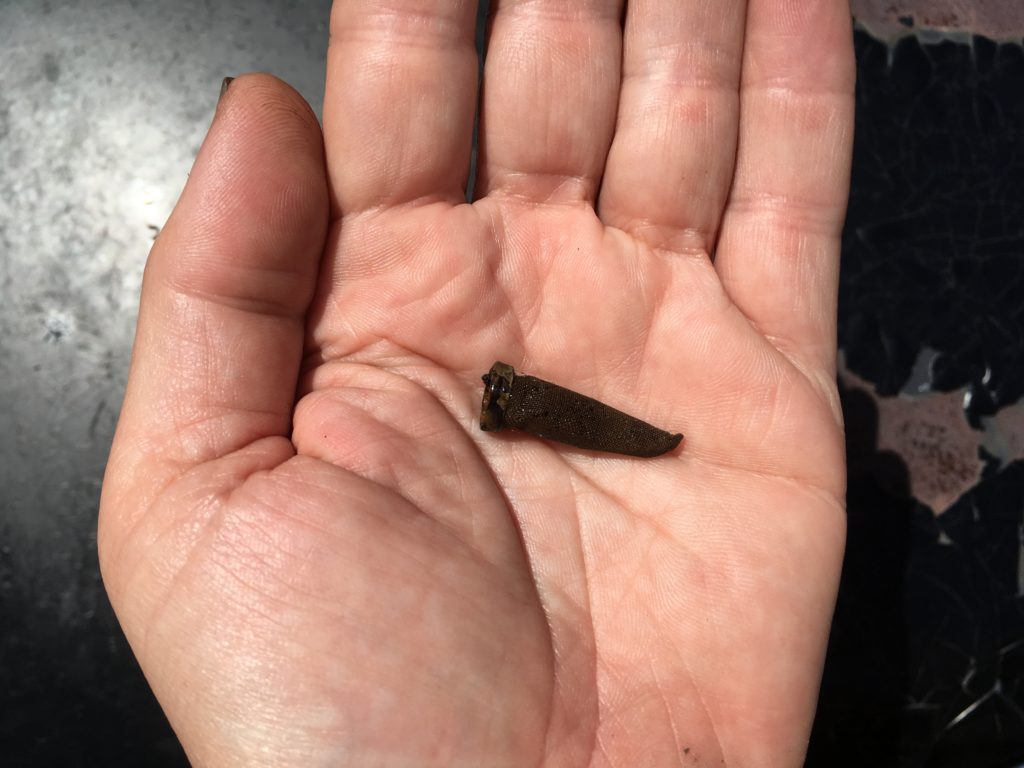
The never-seen-one-removed conical screen for the fuel-pump inlet.
One thing that was completely missing was a standard high-pressure tii fuel filter near the inlet to the Kugelfischer pump. Having seen the awful condition of the gas tank, I was concerned about what might have gotten into K-fish pump and potentially into the injectors. The K-fish pump has a cylindrical mesh screen inside the banjo bolt that goes through the fitting that sends fuel to the cold-start valve; this screen has long been NLA, so if it gets hopelessly clogged or torn, people just remove it. When I removed the banjo bolt and inspected the screen, I was relieved to find it present, intact, and clean.
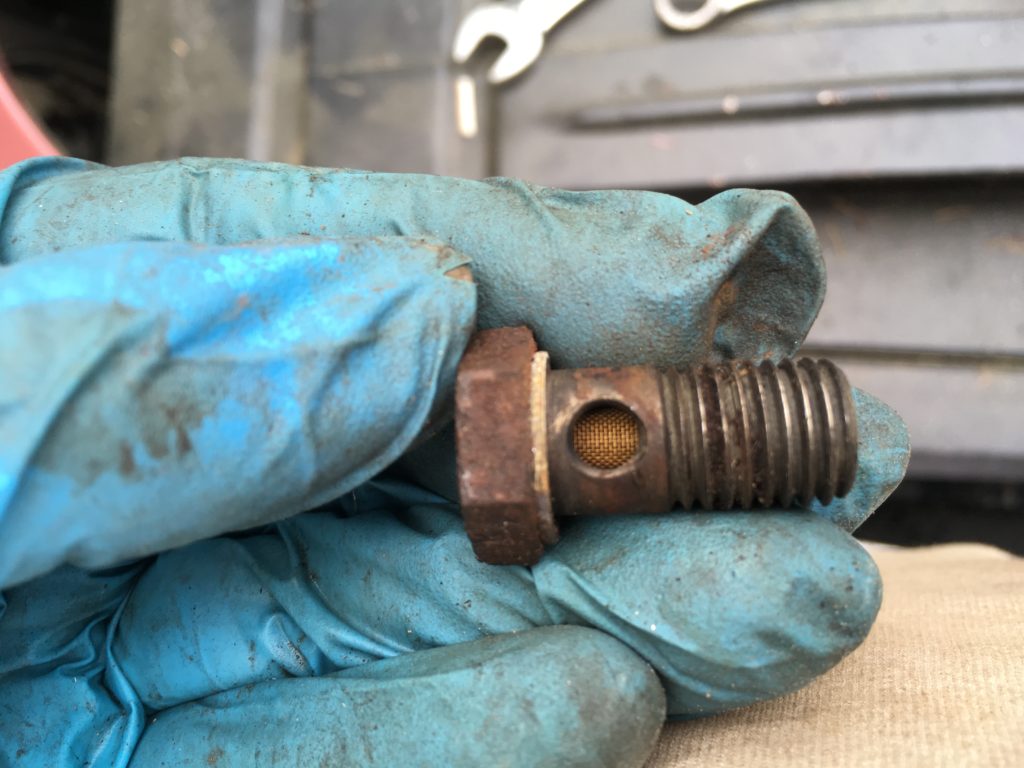
An intact cylindrical K-fish pump screen is a valued part.
Not a bad start. Next week I’ll reassemble the cleaned fuel system, and do the other things necessary before spinning the engine.—Rob Siegel
Rob’s new book, Just Needs a Recharge: The Hack MechanicTM Guide to Vintage Air Conditioning, is available here on Amazon. His previous book Ran When Parked is available here. Or you can order personally inscribed copies of all of his books through Rob’s website: www.robsiegel.com. His next book, Resurrecting Bertha: Buying Back the Car My Wife and I Drove Off From Our Wedding, will be released in the fall.

